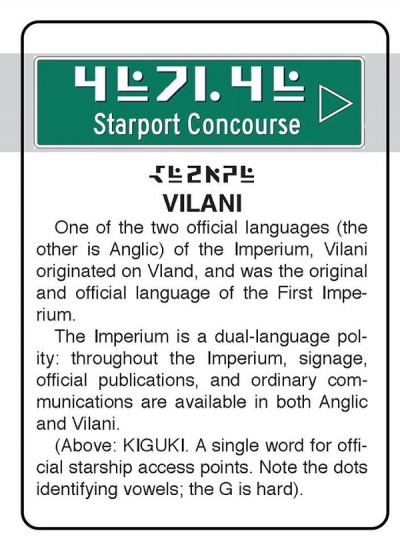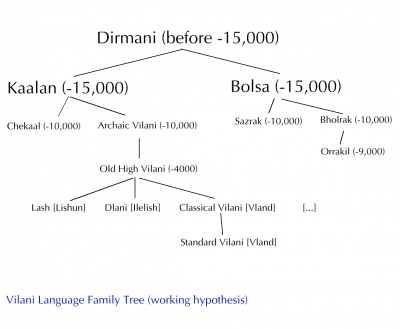Vilani (language)
The Vilani (language) is primarily used by the Vilani race throughout the Third Imperium supra-polity.
- It is a main language used throughout the majority of Charted Space -- especially territories of the former Ziru Sirka.
Description (Specifications)[edit]
No information yet available.
Image Repository[edit]
Structure[edit]
Vilani is an ergative, agglutinative language, with bound morphemes on the verb indicating case and aspects of the agent, patient, and object. Some analytic features, typically inherited from Old High Vilani, include helper words indicating mood. There are also some synthetic/fusional features, inherited from Archaic Vilani.
The language is basically head-initial and right-branching. There are two basic sentence types: transitive and intransitive. Transitive sentences consist of a Verb, an Agent which performs the action of the verb, a Patient which is the recipient of the action, and an optional dative or benefactive Object (for use with things like prepositional phrases). Intransitive sentences consist of a Verb, a Subject to which the verb applies, and the optional dative or benefactive Object as mentioned above. In both cases, the verb contains much of the information regarding the relationship between the subject and objects of the sentence.
Morphology[edit]
Morphology is the study of the internal structure of words.
- Ergativity: Vilani is ergative in its surface structure as well as its underlying syntax structure, meaning that its grammar treats the object of transitive verbs and the subject of intransitive verbs the same, while the subject of transitive verbs is marked in a different fashion.
- This is in contrast with Anglic and most other commonly known Terran languages (one widely known exception being Basque), where the object of transitive verbs is marked in one way (”accusative”) and the subjects and agents of both transitive and intransitive verbs are lumped together into another grammatical category (”nominative”). Ergativity may also be viewed as treating agenthood, rather than patienthood, as the noteworthy or “marked” category.
- The person, proximity, and animacy (but not number) of the “theme participant” (i.e., subject of intransitive verb, object/patient of a transitive verb) are encoded in the verb itself. In addition, the relative degree of animacy between the patient and the agent is also marked in transitive verbs (only).
Phonology[edit]
Phonology, the study of the sound systems of a language.
- Tone: Vilani is a tonal language, meaning that tone patterns make specific changes to words. In particular, tones effect both nouns and verbs. Tone patterns represent combinations of high and low pitched syllables within the Vilani word. There are six tonal patterns used in the Vilani language.
- Certain physical structures and tone are often interchangeable, and usually represent registers of speech rather than grammatical differences.
Grammar[edit]
Grammar is the structure of a language.
- Vilani is ergative and agglutinative, with some synthetic (fusional) aspects, and some analytic aspects. It basically has a Verb – Subject – Object (VSO) word order.
Syntax[edit]
Syntax is the study of how words combine to form grammatical sentences.
- Examples: Intransitive sentences:
1. Leshaa Eneri. Eneri runs.
Leshaa: he-runs
le-: he/she does it
shaa: runs
2. Leshaana Eneri ka duraag. Eneri runs to market.
Leshaana: he-runs-to
-na: ‘to’ prepositional marker
ka duraag: (to) market
ka: flag indicating the start of a dative or benefactive object phrase.
Examples: Transitive sentences:
1. Kikdishaa Enerigim argu. Eneri eats argu.
Kikdishaa: he eats it
ki-: it is being eaten
-k-: he/she is doing the eating
Enerigim: Eneri-does-it
-gim: Eneri is the agent, performing the action
2. Kikdishaani Enerigim argu ka duraag. Eneri eats argu at (the) market.
Kikdishaani: he-eats-it-at
-ni: ‘in, at, on’ prepositional marker
ka duraag: (at) market
ka: flag indicating the start of a dative or benefactive object phrase.
Meaning[edit]
Etymologies: Vilani is the only surviving member of the only surviving branch of a typical human language tree.
- Elements of extinct languages from Vland can be detected in the Vilani lexicon today. For example, words with syllables ending in /b/ or /l/, are almost all borrowed from Chekaal, a cousin of Archaic Vilani. Words with an /h/ (except for /ch/, /kh/, and /sh/) and words ending in /z/ are borrowings from the extremely ancient and long extinct Dirmani people. Finally, words with syllables ending in /kh/ are borrowings from the Sazrak language family.
- Words which have /t/, /ch/, and /o/ in them are Archaic forms of modern Vilani words (which usually use /d/, /kh/, and /aa/ respectively).
- Of particular interest is with words with the syllable /-khal-/, which appear to have originally been Sazrak words which were borrowed by the conquering Chekaal, which were then borrowed into Archaic Vilani.
Lexicology[edit]
See Vilani Lexicon
A lexicon is the word supply of a language.
- Pre-Vilani Borrowings:
Chekaal:
amusement rishnub archive; data library (official) dub-lar fabric palkhur flock, group, herd ? khaalab help, to_ khuulab house, dwelling sakhal < Sazrak new khal < Sazrak incisor dakhaamab jet akhrul < Sazrak language pukhal < Sazrak material palkhur name (esp. of non-human objects?) sakhel < Sazrak scar, to_ khul sharp makhbil < Sazrak tusk dakhammab tree, willow-like_ khaluppu
Dirmani:
duke 'under-king' sarpuhii subordinate khaz beautiful, be_ lamaz
Sazrak:
close (of distance? opposite of open?) akhlu error riikh fold, to_ akhlaash form (existential) adrakh fume, to_ akhrula hammer, to_ duraakh hand naakh house, dwelling sakhla new akhla idiot pakh jet akhlu language pukhla man, male nidakh name (esp. of non-human objects?) sakhle quick, be_ dekh repay, to_ mukh repeat, to_ dakh sharp makhbi splendid, magnificent, be_ makh syllabary, traditional Vilani_ Ruuraakh thin bakh untie, to_ dukh vat or vessel for beer lakhdan yield, to_ gaakh grasslike plant, desert/dryland_ dikh
Archaic Vilani:
fanatic khutak
Semantics[edit]
Semantics is the study of the meaning of words (lexical semantics), and how these combine to form the meanings of sentences.
- Example: Using Topicalization to Answer Questions:
Q. Kikhugashna baan ka Eneri? What happened to Eneri?
Ki-khugash-na: it-happened-to
ki-: done by an inanimate thing
khugash: intransitive verb ‘to happen’
-na: ‘to’ prepositional case
baan: what?
Ka Eneri: (to) Eneri
ka: relational case marker.
A. Liraamgim leskhugash. An air/raft hit (the person in question).
Pragmatics[edit]
Pragmatics is the study of how language is used by its speakers.
- Presupposition, implicature, deixis
History & Background (Dossier)[edit]
Historical Linguistics: Archaic Vilani became a major language of Vland long before the Vilani began interstellar travel. The language developed as the Vilani consolidated their holdings into the First Imperium, and the language adapted to some degree to non-humans as well.
Archaic Vilani[edit]
Archaic Vilani (A.V.) was an inflected language, meaning it used one inflection on the verb to convey case, tense, aspect, and mood. A.V. used a prefix inflection. Vast tables catalogued this often convoluted and complicated prefix. The literary form of A.V. often differed greatly from that commonly spoken.
EXAMPLE:
Some verb inflections:
Sek- I Sed- I (negative) Gak- I (expansive) Gad- I (negative & expansive) Mak- I (diminutive) Mad- I (negative & diminutive) Nak- I (diminutive & cooperative/reciprocal) Nad- I (negative, diminutive, and cooperative/reciprocal) Naa- I (negative, diminutive, cooperative, and dative) Nai- I (negative, diminutive, cooperative, and prescriptive) Nalai- I (negative, diminutive, cooperative, prescriptive future) Nilae- I (negative, diminutive, cooperative, dative, prescriptive, mirative past)
...and so on.
Shar, to slip (AV) Sekshar, I slip. Sesshar, I do not slip (-dsh becomes -ssh). Nasshar, I do not cause myself to slightly slip. Nilaeshar, I did not cause this minor slippage for myself, you know.
...and so on.
Old High Vilani[edit]
Over a thousand years, literary A.V. became increasingly relegated to the court scribes, as Vland was reaching for the stars. Possessed by a grand sense of purpose, grammarians in the Ziru Sirka codified the spoken form of the language, removing or absorbing grammatical differences into the language of the First Imperium. Common helper words were elevated to replace most of the old inflections, completing the evolution to Old High Vilani. This language in many ways resembles the current "Khal" trade cants.
EXAMPLE:
Se, I Mara, small D(u), not / do not, directly prefixed to verb
Naa, cooperative/reciprocal, sometimes suffixed to verb Khe, prescriptive "that which should be -" Mu, mirative
Zad, before / in the past
Essha, to slip (OHV) Se mara desshanaa zad khe mu. "I minorly didn't-slip-up-myself like I ought to have done in the past, you know." Zad mu naa dessha-mara se khe. "Before, of course, the small-self-induced non-slip-up is what I ought to have done."
Standard Vilani[edit]
Bureaux formal language continued to evolve, gradually setting the specific order of helper clitics, then eroding them and sticking them to the verb, resulting in Standard Vilani (S.V.). S.V. today is the formal commercial language of the Vilani worlds and megacorporations. In the Third Imperium, its status is second only to Anglic.
Language Families of Vland[edit]
All dates are 3rd Imperium baseline
- Dirmani (-15,000?)
- Bolsa (-13,500?)
- Sazrak (-12,000)
- Bholrak (-12,000)
- Orrakil (-10,000)
- Kaalan (-13,000)
- Chekaal (-11,000)
- Umshi Chekaal (-9,500)("West Chekaal")
- Chekaalseras (-9,000) ("North Chekaal")
- Chekaal (-11,000)
- Archaic Vilani (-11,000)
- Old High Vilani (-5,000)
- Khal (substrate I)
- Standard Vilani (-2,500)
- Khal (substrate II)
- Caraz (-2,100) (Isolate at Caraz (Trojan Reach 2306))
- Old High Vilani (-5,000)
Khal[edit]
Khal is a "Trade Vilani" language dialect. It represents a holdover of the trade cants based on Old High Vilani, borrowing heavily from Standard Vilani's vocabulary.
- Also called Karak Bilanidin ('Trade Vilani'), Gurek, Segureke, and even the Old High Vilani word Gurib, this is an analytic form of Standard Vilani used on the "frontier" (i.e. any town or world which doesn't have an indigenous Vilani population).
- Khal isn't any one particular entity; it describes a number of pidgins and simplifications of Vilani which are found scattered across the Imperium. Therefore, it's more of a descriptive term than a language name. However, since all varieties of Khal share the Vilani lexicon, they tend to be at least somewhat mutually decipherable.
- In its purest form, Khal uses actual Vilani words, in very simple sentences, with an Anglic grammar. In its basest form, Khal uses Vilanicized Anglic-derived words.
- Khal tends to be analytic; in this respect, it resembles Old High Vilani.
- Khal has a few inflected forms; in this respect, it may be part of the evolution of Standard Vilani into its next phase.
Khal Structure[edit]
Khal is typically Subject - Verb - Object, with ways to change the order for emphasis.
Verbs sometimes use a suffix to inflect for tense, aspect, and mood.
Khal Examples[edit]
(Se) Karak shalap. I trade in shalap. Di karak shalap. You trade in shalap. Menerii karak shalap. You and I trade in shalap. Menerii karak-khaa shalap. Let's trade shalaps. Shalap karak-kaam. Shalap is traded (here). (Se) Karak-i shalap. I did trade in shalap. (Se) Karak-u shalap. I will trade in shalap.
Di. : you
-I. : past tense
-Kaam. : prescriptive/passive "it-is-done"; used to topicalize object
Karak. : trade something
-Khaa. : desiderative ("let's go!")
Menerii. : we (you and I)
Se. : I
Shalap : a pig-like animal
-U. : future tense
Worlds & Sectors (Astrography)[edit]
This language is primarily in use in the following areas:
Charted Space:
- Vilani Space
- Especially the areas of the former Ziru Sirka
Homeworld[edit]
The homeworld of this language is:
World Listing[edit]
This language is known to be in use on the following systems and worlds:
References[edit]
- Loren Wiseman. "Random Notes." Journal of the Travellers' Aid Society 17 (1983): 45-47.
- Jae Campbell. Encyclopaedia Dagudashaag (Signal-GK, 2017), 49.
- Robert Eaglestone. Vilani Grammar and Glossary (Self Published, 2021), .


